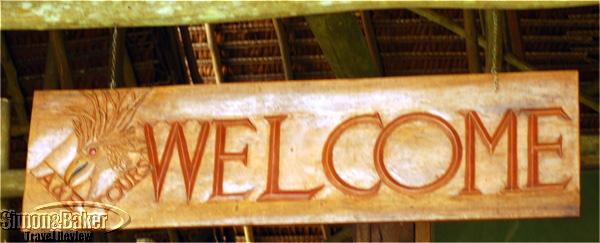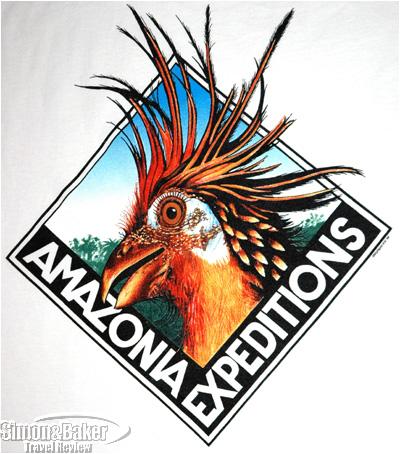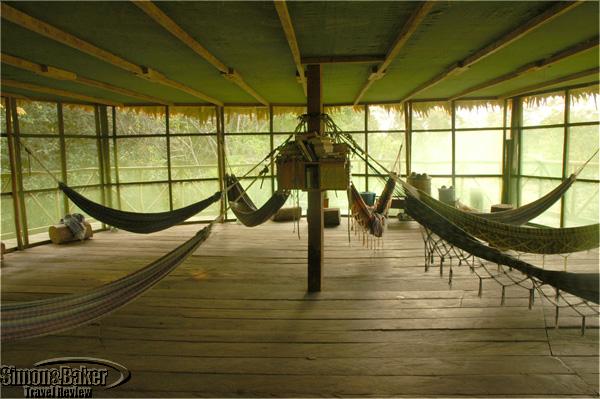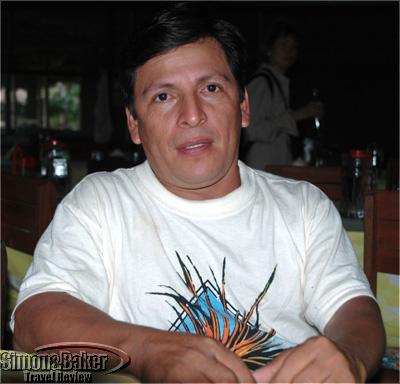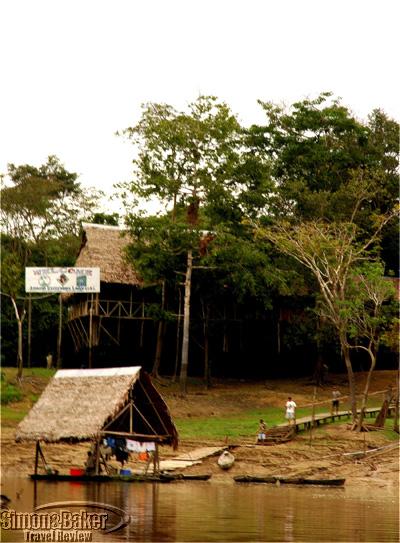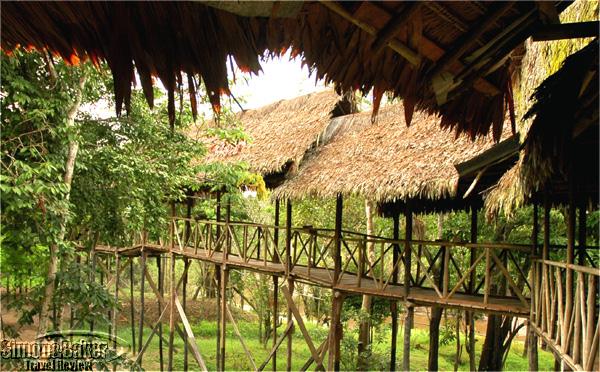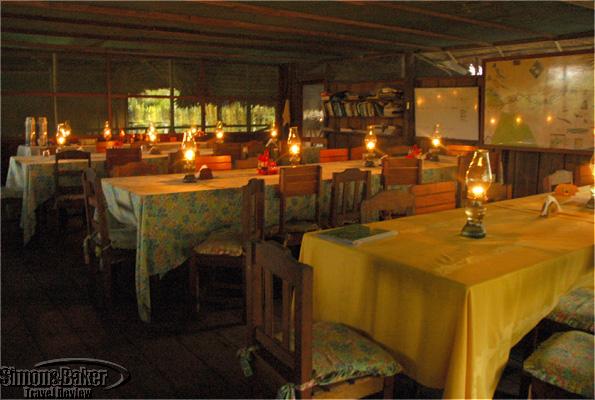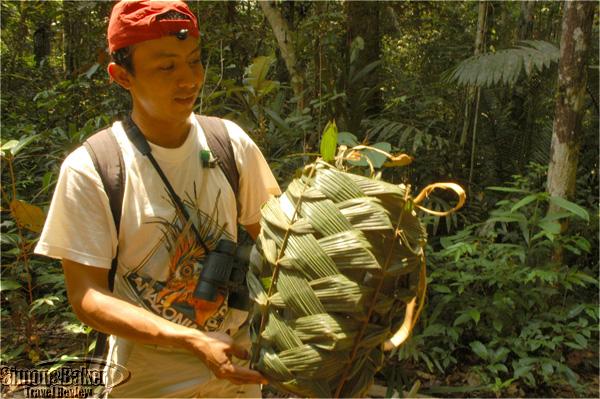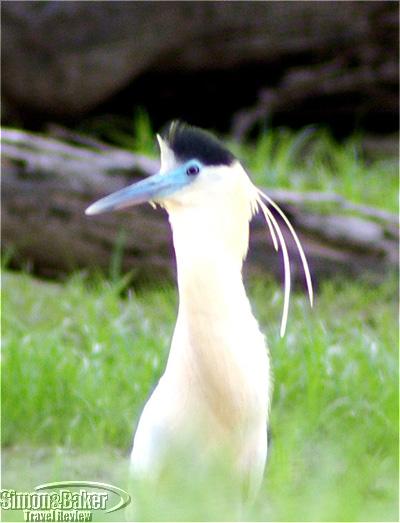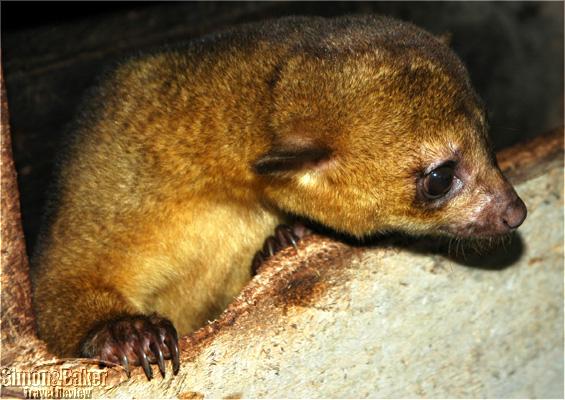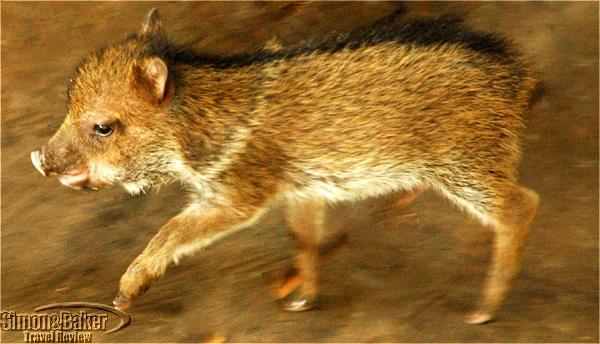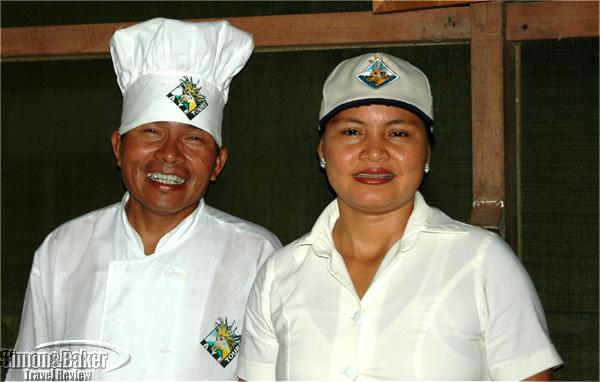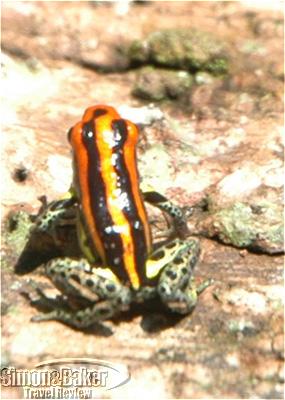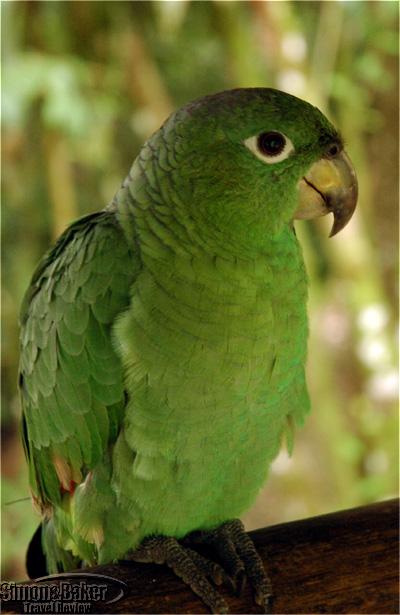
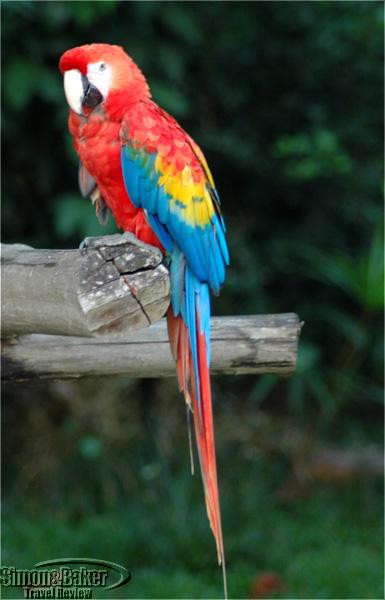
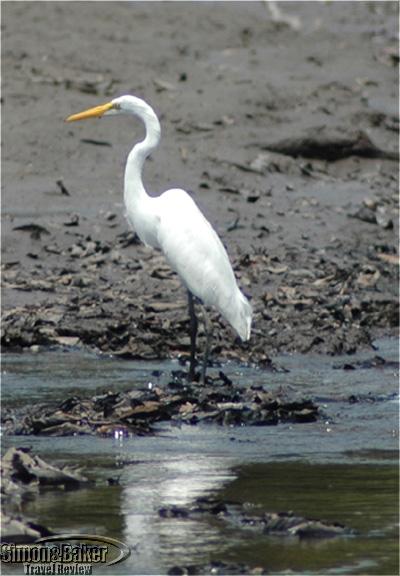
- Overall Impression
- Details
- Description
- Common Areas
- Accomodate
- Dining
- Features
- Wildlife
- Other
- Review
Although it was already mid-afternoon by the time our boat arrived, we were immediately ushered into the cheerful dinning hall where an appetizing buffet lunch appeared on short order. Amazonia Expeditions management personnel quickly welcomed us and gave us a brief orientation tour. Meanwhile, our luggage had materialized in our cabin before we were escorted to it. This same thoughtful, efficient attention to our well-being remained the norm for the duration of our stay.
Established The lodge was built in 1995. It has been in operation ever since and was the object of meticulous on-going maintenance and enhancements. A large research and education laboratory was added in 2000. The latest addition, a circular, 30-foot wide hammock room completed in 2003 was one of our favorite spots to relax and read.
Handicapped Access While the lodge was not configured for handicapped access, we were told that it has successfully accommodated motion and visually impaired guests who have visited as part of a larger group.
Length Of Stay Eight nights
Location The Tahuayo Lodge was located in the Peruvian state of Loreto, approximately 90 miles by motorboat south of Iquitos, the state capital. We first traveled 50 miles upstream on the Amazon before veering off into the Tahuayo River for another 40 miles. The entire trip usually takes between four and five hours depending on the time of year and the water level in the Tahuayo.
Manager Rolex Arevalo
Open All year
Owners Paul and Dolly Beaver
Size The 300-foot facade of the lodge included three spacious common areas connected by seven-foot wide covered walkways. The dinning hall was in the center, with the laboratory and the hammock room at both ends. Similar covered bridges led to the guest cabins and other facilities in the rear. The entire structure was 300 feet by 240 feet, built on stilts ranging from 10 feet to 20 feet in height to accommodate the rolling terrain below and raise the lodge safely over the water level during the rainy season. The architecture blended seamlessly into the 37 acres of jungle that constituted the property. Its boundaries melted into the endless thousands of acres of rainforest surrounding it.
There were 17 guest cabins, capable of accommodating up to 45 guests. Depending on the number of guests in residence, the staff headcount varied from 25 to 30.
Transportation Once at the Tahuayo Lodge, the only ways to get around were by small motorboat, native wooden canoe and on foot.
Room Our Cabin (# 11) was a corner unit in a cluster of eight cabins situated on either side of a large hallway at the rear of the property. The upper quarter of our cedar-paneled 130-square- foot room was screened in, as was the ceiling, to allow air circulation and to let in the sounds of the jungle. The furnishings consisted of two comfortable single beds with mosquito nets, a common bedside table between the two beds, a luggage stand, a small writing desk and two shelves with wooden pegs underneath to hang clothes. The mosquito nets were more a pleasing decorative element than a necessity, as the screening kept our room entirely bug-free
Facilities There were no shopping, dinning or healthcare facilities on the Tahuayo River. All daily guest necessities were provided by the lodge. Supplies could be ordered from Iquitos via short wave radio and delivered by the next boat.
Souvenirs The Amazonia Expeditions T-shirt, with its distinctive hoatzin bird logo was available for sale at the lodge.
Wildlife Viewing Mammals we saw included brown-throated three-toed sloth, pygmy marmoset, saddleback tamarind, squirrel monkey, wooly monkey, kinkajou, collared peccary, pink river dolphin, grey river dolphin, white-lined sack-winged bat, and long-nosed bat. Reptiles included green anaconda, caiman, and great green iguana. Amphibians: cane toad, crested forest toad, duellman’s poison dart frog. Birds: ringed kingfisher, Amazon kingfisher, green kingfisher, capped heron, yellow-rumped cacique, slate-colored hawk, boat-billed flycatcher, black-faced nunbird, needle-billed hermit, scaly-breasted woodpecker, hooded tanager, scarlet macau, mealy parrot, black caracara, orange-winged parrot, festive parrot, greater ani, yellow-headed caracara, black-collared hawk, lesser kiskadee, great kiskadee, black-tailed ant bird, cuvier’s toucan, great egret, turkey vulture, pale-vented pigeon, great black hawk juvenile, great black hawk, white-winged swallow, cobalt-winged parakeet, crimson-crested woodpecker, smooth-billed ani, swallow-tailed kite, chestnut-eared aracari, chestnut-bellied seed-eater, russet-backed oropendola, clay-colored thrush, white-eared jacamar, tropical kingbird, undulated tinamou, yellow-billed tern, ruddy pigeon, and pied lapwing. Birds heard only: striped cuckoo, common potoo, great potoo, ladder-tailed nightjar and hoatzin bird.
The Tahuayo Lodge used two types of water: river water for bathing and bottled water for drinking. The bathing water was pumped from the river into two large tanks where it was purified with chlorine and biodegradable cleansing agents. This treated water was used at room temperature in the showers and in the flush toilets, which relied on a sanitary septic system. In addition, the lodge transported its drinking water from Iquitos in ten-gallon bottles that were placed in dispensers in the kitchen, the dinning hall and by all the open-air sinks. This bottled water was used for cooking, drinking and personal hygiene.
The Tahuayo Lodge was rated “Most acclaimed lodge of Peru’s Northern Amazon” in the 2004 edition of the Guide to Peru (Moon Handbooks).
Date Of Latest Visit August 2005
Reviewers © 2005 Simon and Baker, Inc.
Article by Josette King
Photographs by Josette King
Would You Stay Here Again? Yes
Contact Information
- Amazonia Expeditions
- 103 Riverburn Drive
- Tampa, FL 33647
- +1 800 262 9669
- +1 813 907 8475
